The J.D. Edwards terminology management system (TDB, for “terminology database") provides an excellent case study for just such a workflow tool. J.D. Edwards, a software company that was bought out by a competitor in 2003, developed enterprise software with a focus on financial, manufacturing, and distribution processes, among others. Software developed by J.D. Edwards was translated into 21 languages by an in-house staff of 80 translators and terminologists. Every translator and terminologist specialized in at least one of the business areas, called verticals (e.g., Distribution, Financials, Human Resources, or Oil and Gas). The in-house tools and terminology team developed the terminology management software that will be described below.
Technical specifications
TDB Version 1 was a client-server software application written in Microsoft® Visual Basic and installed on an SQL Server database. To make content accessible to users as far away as China or Brazil and to provide the capabilities required by the J.D. Edwards Marketing department, a Web-based version went live in late spring of 2003. The program comprised 50 database tables, version control, role-based security, and the basic functionality to provide one-dimensional conceptual systems. The "Search and Request," "Research and Validation," "Release," and "Foreign Entry" steps of the integrated workflow depicted in Figure 1 will be discussed in the following sections.
Search and request
Searches are carried out to meet a variety of needs: a translator may be looking for a concept; a writer may be investigating usage; a consultant may be searching for the translation of a particular term; or a terminologist may be doing systematic terminology work. Every time a concept or term is found, the search ends and the database has served its purpose.

Figure 1. The J.D. Edwards terminology workflow (see also Karsch 2002: 175).
In the event that a search yields no results because a term is not present in the database, the searching party can trigger the launch of a request form. To do so, the originator must provide all required information: J.D. Edwards' standards mandate that the term, context, part of speech, and vertical all be supplied. The entry form also contains a Comments field that allows for additional information and communication between the requester and the researcher. Upon submission, the entry's status is automatically set to “Requested.”
上一篇:The Business Value Of Translation Memory And Standards
下一篇:Thoughts On Building A Case For Managing Source Terminology

微信公众号搜索“译员”关注我们,每天为您推送翻译理论和技巧,外语学习及翻译招聘信息。